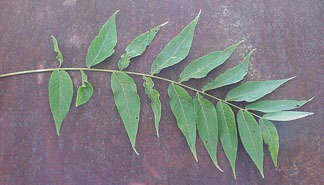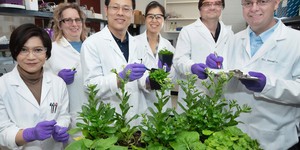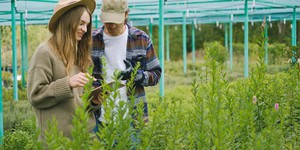Abstract
Every spring, gardeners around the world get ready to plant their summer gardens. They turn the soil over in their garden plots and add nutrients to the soil. Then they plant their seedlings and wait for nature to provide a bounty of fruits, vegetables, and flowers. But nurturing the garden doesn't stop there. In order to get lots of fruits and vegetables, the gardener must eliminate factors that can hurt the plants. Sometimes, chemicals in the soil from other plants and trees can hurt a garden. In this plant biology science fair project, you will study the toxic effects that some plants can have on other plants.Summary
Michelle Maranowski, PhD, Science Buddies
This science fair project is based on one found at The NEED project website:
- The NEED Project. (n.d.). Natural Herbicide. Retrieved April 14, 2009.

Objective
The goal of this plant biology science fair project is to study the allelopathic effect of black walnut trees on tomato plants.
Introduction
Gardening is a fun and healthy hobby. Planting a seedling in the garden is like a promise. You promise to provide the plant with water, nutrients, and light and the seedling promises to grow and give you plenty of fruits or vegetables. Some people find that gardening is relaxing because you can forget about the things that happened during the day and just concentrate on your plants. But did you know that deciding where the garden is placed can affect how well the seedlings thrive?
For example, you want to make sure that the plants get enough water, nutrients, and light. Gardens need to be planted away from big trees that can shadow them and compete for nutrients. Another issue to think about is that certain trees produce chemicals that can be harmful to plants. Black walnut trees are an example of trees that are toxic to certain plants. In fact, even when a black walnut tree is removed, the soil in which it was growing can be toxic to surrounding plants for many years.
 Image Credit: Lerner, R., Department of Horticulture and Landscape Architecture, Purdue University / Permission granted by Purdue University, Horticulture Dept. via e-mail.
Image Credit: Lerner, R., Department of Horticulture and Landscape Architecture, Purdue University / Permission granted by Purdue University, Horticulture Dept. via e-mail.
Figure 1. Black walnut leaf with 18 leaflets. (R. Lerner, Purdue University, 2000.)
The toxic effects of the black walnut tree have been known since the time of the Romans. The black walnut tree (whose genus name is Juglans nigra L.) makes an allelopathic (uh-LEH-lo-PA-thik) substance, called juglone. Allelopathy is when a plant adds a substance to the soil that inhibits the growth of surrounding vegetation. Juglone inhibits plant respiration. In respiration, plants take in oxygen to convert the food they made during photosynthesis into energy. When a plant doesn't have enough energy, its leaves turn yellow, and the plant wilts and dies. Juglone is present in the leaves, bark, nut hulls, buds, and the roots of the black walnut tree. While black walnut trees have an allelopathic effect on the surrounding vegetation, many people rely on the health benefits of the black walnut. The nut meat is high in omega-3 fatty acids, which aids in cardiovascular fitness. The Native Americans used black walnut as a laxative. Juglone is also used in food and in hair dyes.
Black walnut trees are found in the eastern half of the United States, from Maine to southern Michigan, and all the way down to Texas and Georgia. It is a tree that can grow up to 100 feet tall and 50–75 feet in width. The leaves are 12–24 inches long and are composed of 15–23 leaflets. The tree grows best in deep, well-drained, and loamy soil.
In this plant biology science fair project, you will study the toxicity of the black walnut tree on tomato plants. You will make and test a juglone solution made from the leaves of the black walnut tree and test this solution on tomato plants to see how different doses affect the plant.
Terms and Concepts
- Toxic
- Genus
- Juglone
- Allelopathy
- Respiration
- Photosynthesis
- Loam
Questions
- Which plants are and are not tolerant of the black walnut tree?
- What other kinds of trees and plants have allelopathic properties?
Bibliography
- West Virginia University Extension Service. (n.d.). Black Walnut Toxicity. Retrieved April 16, 2009.
- Virginia Cooperative Education. (2000, January). Trees for Problem Landscape Sites—The Walnut Tree: Allelopathic Effects and Tolerant Plants. Retrieved April 16, 2009.
The next two entries discuss allelopathy:
- University of Florida IFAS Extension. (2008). Allelopathy: How Plants Suppress Other Plants. Retrieved April 16, 2009.
- Wikipedia Contributors. (2009, April 15). Allelopathy. Wikipedia: The Free Encyclopedia. Retrieved April 16, 2009.
Materials and Equipment
- Black walnut tree leaflets (60) plucked from the tree
- Note: Be sure you only pick the tree leaves if they are on your property or if you have special permission if you are on someone else's property. You should never disturb wildlife in parks.
- Pot, 4-quart (qt.)
- Stopwatch
- Slotted spoon
- Water
- Plastic storage containers, 2-qt. (2)
- Permanent marker
- Jigger, 1-ounce (oz.) x 2-oz; available from local home goods stores
- Disposable gloves. Can be purchased at a local drug store or pharmacy, or through an online supplier like Carolina Biological Supply Company. If you are allergic to latex, use vinyl or polyethylene gloves.
- Tomato plants, each in its own pot (9). Don't use plants that are too young. Use plants that are around 8 inches tall. The plants should all be similarly sized. The plants' soil should be moist prior to starting the science fair project.
- Lab notebook
- Graph paper
Disclaimer: Science Buddies participates in affiliate programs with Home Science Tools, Amazon.com, Carolina Biological, and Jameco Electronics. Proceeds from the affiliate programs help support Science Buddies, a 501(c)(3) public charity, and keep our resources free for everyone. Our top priority is student learning. If you have any comments (positive or negative) related to purchases you've made for science projects from recommendations on our site, please let us know. Write to us at scibuddy@sciencebuddies.org.
Experimental Procedure
- Place 20 black walnut leaves in the pot and fill the pot half full with water.
- Put the pot on the stove and bring it to a boil. Boil the leaves and water for 10 minutes. Use the stopwatch to keep track of time.
- After 10 minutes, use the slotted spoon to remove the leaves from the water.
- Continue to boil the concoction for 20 minutes. You have now made your juglone solution. After 20 minutes, allow the liquid to cool completely. Once the liquid has cooled, transfer it to one of the plastic storage containers.
-
Place nine tomato plants in a sunny location. Put on your gloves. Pour solution on each plant at dusk every day, as follows. Make sure that the soil is moist, but not wet. If the juglone solution does not moisten the soil, add additional water to the plant so that it is moist.
- Using the 2-oz. jigger, measure 2 oz. of juglone solution. Water the first tomato plant with 2 oz. of juglone solution. Label that plant's container 2 oz. Juglone in order to keep track of how you are treating the plants. Repeat this step with two more tomato plants.
- Using the 1-oz. jigger, measure 1 oz. of juglone solution. Water the second tomato plant with 1 oz. of juglone solution and 1 oz. of water. Rinse out the jigger. Label the plant container 1 oz. Juglone + 1 oz. water. Repeat this step with two more tomato plants.
- Water the third tomato plant with 2 oz. of plain water. Be sure the jigger was rinsed out well. Label the container Plain water. Repeat this step with two more tomato plants.
- Keep track of the amount of juglone solution you have and make more, as needed, following steps 2–4.
- Repeat step 5 every day for at least seven days. Water the plants at the same time every day, around dusk. Observe your plants. Do you notice any changes in the leaves' color? How do the stems appear? Record all of your observations, along with the day that you made the observation, in your lab notebook in a data table like the one shown below.
| Solution Dose | Trial | 1st Watering Date and Observations | 2nd Watering Date and Observations | 3rd Watering Date and Observations | 4th Watering Date and Observations | 5th Watering Date and Observations |
| 2 oz. Juglone Solution | ||||||
| 1 oz. Juglone Solution | ||||||
| Plain Water | ||||||
- How did the juglone solution react with the tomato plants? How many days did it take for the plant that received 2 oz. of juglone solution to die? How long did it take for the plant that received 1 oz. of juglone solution to die? Plot your data on the graph paper. Label the x-axis Solution Dose and the y-axis Days Until Plant Died.
Ask an Expert
Global Connections
The United Nations Sustainable Development Goals (UNSDGs) are a blueprint to achieve a better and more sustainable future for all.
Variations
- Vary the concentration of the juglone in the water. Use 40 leaves to make the herbicide. Using 2-oz. doses, how long will it take to kill a plant?
- Test the allelopathic effects of juglone on other plants (remember, do not use any plants in your yard or garden, as the toxic juglone can remain in the soil for many years).
- Make a natural herbicide from a different source and compare its efficacy to the black walnut herbicide.
- Do the herbicides work if they are poured directly into the soil? Or do the herbicides work better if they touch the leaves and stems?
Careers
If you like this project, you might enjoy exploring these related careers:











